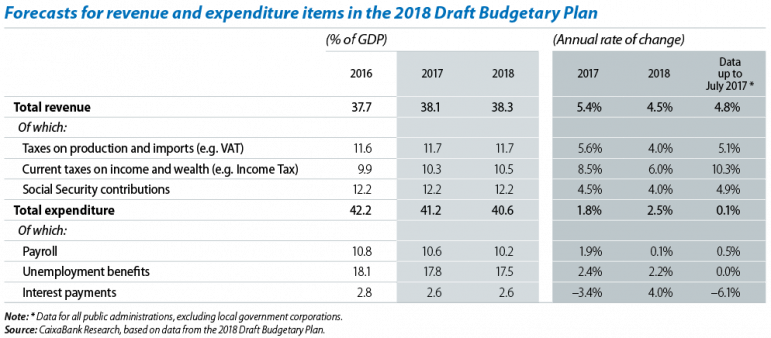Ten years of budget deficit and counting
Spain’s public sector accounts are still in the red. The budget deficit will probably reach 3.1% of GDP in 2017, with general government spending exceeding revenue, for the tenth year in a row. A glass half-full approach, however, notes that the economic recovery and measures to control and cut the expenditure of public administrations over the past few years have led to a downward trend in the budget deficit. As a result, Spain looks like achieving the fiscal balance target for 2017 agreed with the European Commission.
With this year about to end, however, it is useful to examine the accounts for the coming year. The Spanish government sent its 2018 Draft Budgetary Plan to the European Commission in October. The support of a parliamentary majority for the Budget is still in the air. Nevertheless, this Plan is based on a scenario that essentially prolongs 2017’s policies and relies on economic growth to reduce the budget deficit.
According to the Plan, GDP growth, forecast at 2.3%, will reduce the fiscal balance to –2.3% of GDP in 2018. Although an improvement of 0.8 pp, this will not be enough to achieve the target of –2.2% of GDP contained in the Stability Programme and agreed with the European Commission.
Expenditure measures are also expected to improve the public accounts. Public sector wages are frozen and unemployment is likely to fall by 1.7 pp, reducing the payment of unemployment benefits by 2.9%. The central government also estimates that interest payments will rise in line with nominal GDP growth (4.0%). This projection seems very conservative, given that the average maturity of public debt is longer than seven years and interest rates are considerably lower than in previous years (and are expected to remain very low in 2018). In fact, interest payments had fallen by 6.1% up to July 2017 compared with the same period in 2016.1
Regarding revenue, the central government estimates that the positive trend in employment (2.4% in 2018) will boost Social Security contributions, growing by 4% in 2018. The Draft Budgetary Plan also projects that revenue from taxes on production and imports (mainly VAT) will rise by 4%. This forecast is also in line with the macroeconomic situation of household consumption continuing as one of the major supports for the recovery. Nevertheless, the 6% increase forecast in revenue from taxes on income and wealth seems rather optimistic.2
In short, the estimates contained in the Draft Budgetary Plan seem plausible. These predict that economic growth will push the budget deficit below 3% of GDP and therefore help Spain to exit its excessive deficit procedure. Nevertheless, all the evidence points to Spain’s public accounts remaining in the red until after 2020. Moreover, measures to reduce the fiscal deficit will still be required to ensure that public debt, which is close to 100% of GDP, also starts to fall. The wisest move would be to take advantage of the years of economic growth to improve the accounts and thereby have more margin to act when low growth comes as a surprise.
1. Expenditure by all public administrations, excluding local government corporations.
2. A forecast based on the historical elasticity (1998-2016) between these taxes and nominal GDP would be around 4.5%.



